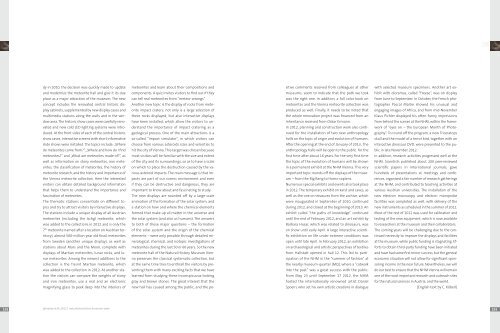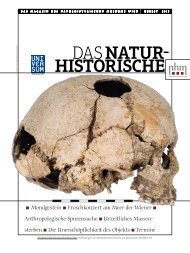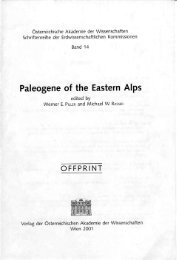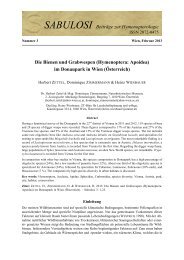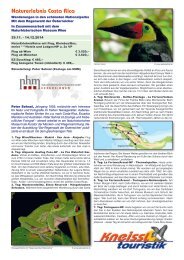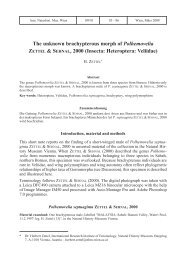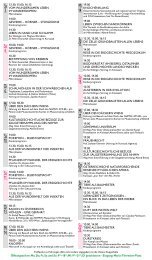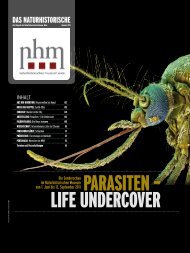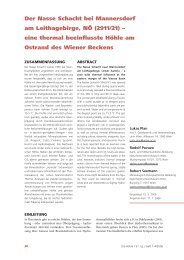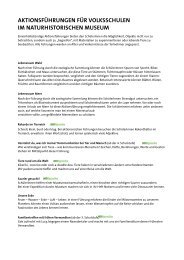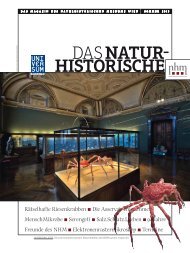jahresbericht 2012 - Naturhistorisches Museum Wien
jahresbericht 2012 - Naturhistorisches Museum Wien
jahresbericht 2012 - Naturhistorisches Museum Wien
Erfolgreiche ePaper selbst erstellen
Machen Sie aus Ihren PDF Publikationen ein blätterbares Flipbook mit unserer einzigartigen Google optimierten e-Paper Software.
08<br />
dy in 2010, the decision was quickly made to update<br />
and modernize the meteorite hall and give it its due<br />
place as a major attraction of the museum. The new<br />
concept includes the renovated central historic display<br />
cabinets, supplemented by new display cases and<br />
multimedia stations along the walls and in the window<br />
area. The historic show cases were carefully renovated<br />
and new cold LED lighting systems were introduced.<br />
At the front sides of each of the central historic<br />
show cases, interactive screens with short informative<br />
slide shows were installed. The topics include: „Where<br />
do meteorites come from?“, „Where and how do I find<br />
meteorites?“ and „What are meteorites made of?“, as<br />
well as information on stony meteorites, iron meteorites,<br />
the classification of meteorites, the history of<br />
meteorite research, and the history and importance of<br />
the Vienna meteorite collection. Here the interested<br />
visitors can obtain detailed background information<br />
that helps them to understand the importance and<br />
fascination of meteorites.<br />
The thematic stations concentrate on different topics<br />
and try to attract visitors by interactive displays.<br />
The stations include a unique display of all Austrian<br />
meteorites (including the Ischgl meteorite, which<br />
was added to the collections in <strong>2012</strong> and is only the<br />
7 th meteorite named after a location on Austrian territory),<br />
almost 500-million-year old fossil meteorites<br />
from Sweden (another unique display), as well as<br />
stations about Mars and the Moon, complete with<br />
displays of Martian meteorites, lunar rocks, and lunar<br />
meteorites. Among the newest additions to the<br />
collection is the Tissint Martian meteorite, which<br />
was added to the collection in <strong>2012</strong>. At another station<br />
the visitors can compare the weights of stony<br />
and iron meteorites, use a real and an electronic<br />
magnifying glass to peek deep into the interiors of<br />
meteorites and learn about their compositions and<br />
components. A quiz invites visitors to find out if they<br />
can tell real meteorites from “meteor-wrongs”.<br />
Another new topic is the display of rocks from meteorite<br />
impact craters; not only is a large selection of<br />
these rocks displayed, but also interactive displays<br />
have been installed, which allow the visitors to understand<br />
the importance of impact cratering as a<br />
geological process. One of the main attractions is a<br />
so-called “impact simulator”, in which visitors can<br />
choose from various asteroids sizes and velocities to<br />
hit the city of Vienna. This target was chosen because<br />
most visitors will be familiar with the size and extent<br />
of the city and its surroundings, so as to have a scale<br />
on which to place the destruction caused by the various<br />
asteroid impacts. The main message is that impacts<br />
are part of our cosmic environment and even<br />
if they can be destructive and dangerous, they are<br />
important to know about and fascinating to study.<br />
The new displays are rounded off by a large-scale<br />
animation of the formation of the solar system, and<br />
a station on how and where the chemical elements<br />
formed that make up all matter in the universe and<br />
the solar system (and also us humans). The answers<br />
to both of these major questions – the formation<br />
of the solar system and the origin of the chemical<br />
elements – were only possible through detailed mineralogical,<br />
chemical, and isotopic investigations of<br />
meteorites during the last 50 or 60 years. So the new<br />
meteorite hall of the Natural History <strong>Museum</strong> Vienna<br />
preserves the classical systematic collection, but<br />
at the same time tries to enthrall the visitors by presenting<br />
them with many exciting facts that we have<br />
learned from studying these inconspicuous-looking<br />
gray and brown stones. The great interest that the<br />
new hall has caused among the public, and the positive<br />
comments received from colleagues at other<br />
museums, seem to indicate that the path we took<br />
was the right one. In addition, a full color book on<br />
meteorites and the Vienna meteorite collection was<br />
produced as well. Finally, it needs to be noted that<br />
the whole renovation project was financed from an<br />
inheritance received from Oskar Ermann.<br />
In <strong>2012</strong>, planning and construction work also continued<br />
for the installation of two new anthropology<br />
halls on the topic of origin and evolution of humans.<br />
After the opening at the end of January of 2013, the<br />
anthropology halls will be open to the public for the<br />
first time after about 16 years. For the very first time<br />
the topic of the evolution of humans will be shown<br />
in a permanent exhibit at the NHM Vienna. This very<br />
important topic rounds off the displays of the museum<br />
– from the Big Bang to Homo sapiens.<br />
Numerous special exhibits and events also took place<br />
in <strong>2012</strong>. The temporary exhibit on karst and caves, as<br />
well as the one on treasures from the archive, which<br />
were inaugurated in September of 2010, continued<br />
during <strong>2012</strong>, and closed at the beginning of 2013. An<br />
exhibit called “the paths of knowledge” continued<br />
until the end of February <strong>2012</strong>, and an art exhibit by<br />
Barbara Husar, which was related to dinosaurs, was<br />
on show until early April. A large interactive scientific<br />
exhibition on life under extreme conditions was<br />
open until late April. In February <strong>2012</strong>, an exhibition<br />
on archaeological and artistic perspectives of textiles<br />
from Hallstatt opened in hall 12. This led to participation<br />
of the NHM in the “summer of fashion” at<br />
the nearby museum-quarter (MQ), where a “catwalk<br />
into the past” was a great success with the public.<br />
From May 23 until September 17 <strong>2012</strong>, the NHM<br />
hosted the internationally renowned artist Daniel<br />
Spoerri, who set his own artistic creations in dialogue<br />
with selected museum specimens. Another art exhibit<br />
with dioramas, called “Freeze”, was on display<br />
from June to September. In October, the French photographer<br />
Pascal Maitre showed his unusual and<br />
engaging images of Africa, and from mid-November<br />
Klaus Pichler displayed his often funny impressions<br />
from behind the scenes at the NHM, within the frame -<br />
work of “eyes on – the European Month of Photography”.<br />
To round off the program, a new Triceratops<br />
skull and the model of a terror bird, together with an<br />
interactive dinosaur DVD, were presented to the public<br />
in late November <strong>2012</strong>.<br />
In addition, research activities progressed well at the<br />
NHM. Scientists published about 200 peer-reviewed<br />
scientific papers in international journals, gave<br />
hundreds of presentations at meetings and conferences,<br />
organized a fair number of research gatherings<br />
at the NHM, and contributed to teaching activities at<br />
various Austrian universities. The installation of the<br />
new electron microscopy and electron microprobe<br />
facilities was completed as well, with delivery of the<br />
new instruments as scheduled in the summer of <strong>2012</strong>.<br />
Most of the rest of <strong>2012</strong> was used for calibration and<br />
testing of the new equipment, which is now available<br />
to researchers at the museum and their collaborators.<br />
The coming years will be challenging due to the continued<br />
necessity to improve the displays and facilities<br />
at the museum, while public funding is stagnating. Efforts<br />
to obtain third-party funding have been initiated<br />
and have had some first minor success, but the general<br />
economic situation will not allow for significant sponsoring<br />
income in the near future. Nevertheless, we will<br />
do our best to ensure that the NHM Vienna will remain<br />
one of the most important research and outreach sites<br />
for the natural sciences in Austria, and the world.<br />
(English text by C. Köberl)<br />
<strong>jahresbericht</strong> <strong>2012</strong> | naturhistorisches museum wien<br />
192 193


